LABA'AN II AL KHALIJ
The History of the most famous Saluki in the
French Société Centrale Canine (affiliated with FCI) Sloughi
Registry.
© Sloughiman
Looks versus Cultural, Geographic and Genetic
Uniqueness
Argument 1
Sloughis are registered and judged according
to their looks alone, it does not matter where they come from
Wrong
1) The imports are registered within the Fédération
Cynologique Internationale (FCI) according to their countries of origin
The FCI's Sloughi standard states that the main
country of origin of the Sloughi is Morocco and that this always short
coated breed comes from North Africa. Dogs imported from Morocco, Algeria,
Tunisia and Libya have been and still are registered with the FCI.
The FCI's Saluki standard states that this breed
which exists in 2 types of coat, short or long-haired, comes from the Middle
East..................... The Middle East is not North Africa.
2) the countries of origin are crucial for indigenous
breeds whether Sloughi, Saluki or other sighthound breeds. The Country
of Origin and the Culture which bred these Sighthounds are what defines
indigenous breeds.
The distance between these countries is of utmost
importance because it gives an indication as to whether these populations
were in contact with each other or not during their evolution and history.
The greater the geographic distances, the less the dogs interbreed and
the greater the chances of genetic isolation and resulting Genetic Drift
which modifies the DNA over time.
Examples: the distance between Rabat (Morocco)
and Riyadh (Saudi Arabia) by flight is 5192.2 kms (3226.3 miles), between
Rabat (Morocco) and Kabul (Afghanistan) by flight is 6777.9 kms (4211.6
miles) somewhat equivalent to the distance by flight between Paris (France)
and New York (USA) of 5827.5 kms (3621 miles). These distances are much
longer by road.
3) this argument implies that any lopeared short
coated Sighthound showing up in rescue is a Sloughi. Looks can be very
deceiving, there are many crossbreds which look superficially like Sloughis.
Many Longdogs (crosses between Sighthounds) and Lurchers (crosses between
Sighthounds and other breeds) which show up in rescue as "Sloughis" are
good examples of how confusing it can be.
Does that mean that such crossbreds should be
registered with the FCI in the first generation?
No, because they do not come from North Africa,
even if some have Sloughi blood, particularly in the United Kingdom where
hunters have quickly realized the hunting talent of the Sloughi and blended
the Sloughi DNA into their Longdogs and Lurchers.
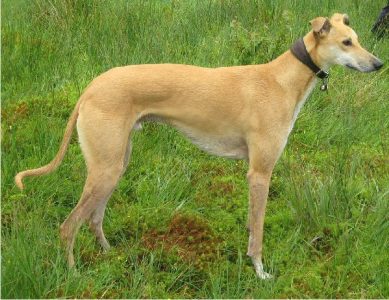  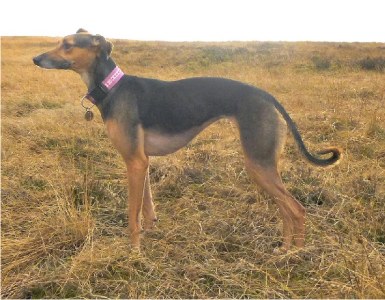 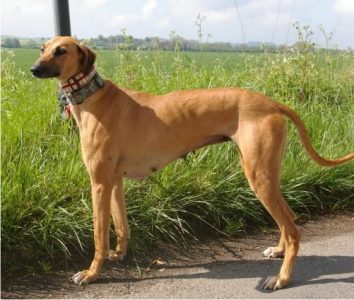
© Mathews
~ © Mathews ~ © Mackay
~ © Windebank
4 Lurchers with Sloughi-ish looks
From Left to right: Mix half Sloughi
half Greyhound/Whippet/Saluki/English Bull Terrier/and more.
travellers dog, dumped at a hare
coursing site. He was taken in by the largest Lurcher Rescue group
in the UK and advertised as a Saluki cross
Mix half Sloughi half Greyhound/Whippet/Saluki/English
Bull Terrier/and more.
Right: Another travellers dog from
Ireland, also advertised as a Saluki cross in Rescue. This bitch's son
is feathered.
Travellers are notorious for the
way they cross breeds for hunting, the most common cross being Greyhound/Saluki,
but Sloughis are also used, as well as non- Sighthound breeds.
For comparison, Sloughis of British Breeding
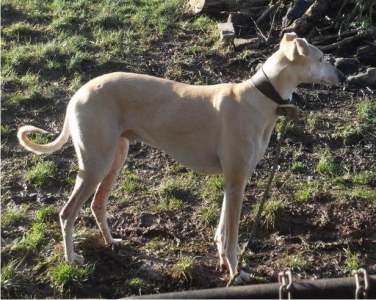 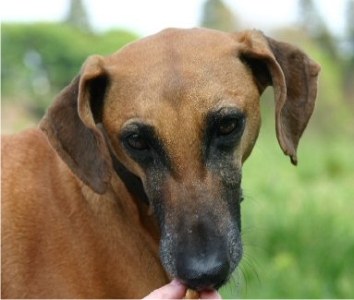 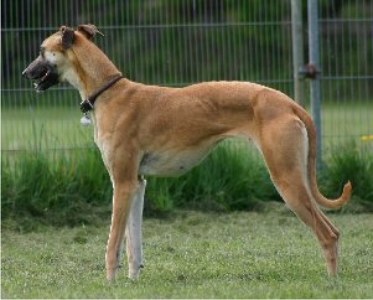
© Mathews
~ © Clare
~ © Clare
Argument 2
Genetics are not important because before the
field of Genetics was developed people bred on looks alone
Wrong, before
the field of Genetics was developed people bred with local lines selected
in a particular environment, in a particular cultural setting/society and
for a specific function. These local lines of indigenous Sighthounds did
not for the most part come into contact with large scale genetic exchanges
with similar looking Sighthounds thousands of kms away.
They did not breed with each other because they
could not due to the distance, therefore they did not mix their DNA which
evolved differently across centuries as a result of Genetic Drift.
It is only during the last century, because of
the ease and speed of travelling, that dog breeds from far away came into
contact with each other. This applies to all dog breeds, and it includes
the Sloughi and the Saluki. The ease and speed of travelling is the most
important danger to the preservation of local indigenous breeds.
In fact scientific studies on the Genetics of
dog breeds show so far that Sloughis and Salukis do not have the same DNA.
They have unique parts of their DNA equivalent to differences used to identify
samples determining the outcome of criminal cases in the courts of Law.
Argument 3
Laba'an II al Khalij never produced long-haired
puppies, so crossbreeding to him does not matter.
Wrong, that
remains to be proven, as there is a written testimony saying that about
50% of the puppies were destroyed by the breeder at the time.
Why were they destroyed one may ask?
A short coated Saluki does not have the DNA of
a North African Sloughi.
Short coated Salukis can be either carrier for
long hair (heterozygous, they have one allele instead of 2 of the gene
for long hair) or "clear" for long hair (homozygous for short hair,
they have no alleles of the gene for long hair).
Two short coated Salukis carrier for long hair
will produce litters of short coated and long haired Salukis, because the
single allele of each parents will combine in some of the pups who will
then have both alleles of the gene for long hair and therefore be longhaired
(long hair is inherited recessively).
Being short haired does not make a Saluki a Sloughi.
A short coated Saluki has the DNA of the Saluki, it has the same DNA as
his feathered relatives except for the gene which produces long-hair, one
gene out of roughly 20.000 genes.
Breeding Sloughis to Salukis or Afghan Hounds
or Greyhounds or Whippets is creating mongrels out of formerly geographically
distinct populations, it does not matter how pretty they are.
Hunters in the UK and the USA want crossbreds
to hunt, there is really no problem with that, but they have the decency
of not messing up the Studbooks of these breeds by registering such mongrels
as pure-breds of these breeds.
Argument 4
Sloughis in North Africa could be mongrels
because most have no pedigrees, we should not breed with them.
Wrong, this
is a colonial, arrogant and demeaning attitude towards the traditional
breeders of Sloughis in North Africa.
There are crossbreds in every country of the
world so if there are mongrels in North Africa it is nothing special.
However, let us not forget that the North
African Sloughis were bred and selected by traditional breeders over centuries
in North Africa long before the creation of dog shows and registries.
Traditional Sloughi breeders know the difference between a Sloughi and
a dog which is not a Sloughi.
It is from traditionally bred North African Sloughis
that the "real" Sloughi bloodlines in the West descend from.
As seen with the scam of the Western registration
of the Saluki Laba'an II al Khalij as a Sloughi, registries and their pedigrees
are not always a guarantee of purity of breeding, and what is the point
of a pedigree which shows dogs of other breeds?.
Although there is nothing wrong with presenting
a Sloughi at a dog show, and with the pleasure of winning, the fact of
the matter is that the Sloughis bred in North Africa are not bred to trott
prettily around a show ring and bring back a ribbon to the owner.
Their value resides in their selection by traditional
breeders for their talent and courage in hunting and guarding, and the
resulting good instincts, looks and structure. Few breeds still have access
to the populations they originated from. The breed Sloughi is fortunate
in that it still has populations bred traditionnally in North Africa which
can be a repository of a rich gene pool. Serious Western breeders incorporate
such bloodlines to prevent the disastrous consequences of inbreeding which
plague the show dogs of many breeds in the West.
Whether these Sloughis have Western style pedigrees
is irrelevant. North African traditional breeders know their bloodlines,
they are the ones who bred this breed for centuries. And a pedigree can
be started within the FCI system for Sloughis imported from North African
countries with no Western type Registration System.
Argument 5
My dog is a champion, it implies it is a Sloughi.
Wrong although
the registration at the beginning of a registered bloodline, if the owner
is honest, is made according to the country of origin, a judge can only
evaluate the looks of a particular dog which has been registered with the
FCI in the show ring.
1) a judge cannot know the bloodlines and the
mixes in the lineages of the dog he or she judges.
2) a judge can be knowledgeable or not knowledgeable
about the North African Sloughi. A judge with little in depth knowledge
of the breed will not recognize proper North African Sloughi type.
3) the crossbreds of Sloughi with Saluki blur
the morphological differences between the breeds because they look somewhat
"in between" these 2 breeds and make it difficult for a judge to recognize
what they are.
Argument 6
It does not matter anyway, Sloughi and Saluki
are the same anyway
Wrong, that
may be a personal opinion, not supported by the results of genetic studies,
but within the Fédération Cynologique Internationale which
includes Morocco, these breeds are recognized as distinct, Sloughi
and Saluki are different breeds.
So it logically and legally follows that one
should not be able to register a Saluki as a Sloughi and a Sloughi as a
Saluki and that the puppies of a Saluki with a Sloughia (or vice
versa) are mongrels and should never have been registered with the FCI.
If someone likes the look of crossbreds between
these Sloughi and Saluki, there is no problem with that as long as they
do not register them as pure bred Sloughis and thus mess up the integrity
of the Sloughi Studbook and of the bloodlines with Saluki foreign genes
which do not belong there.
In addition such crossbreds should NEVER be
exported to North Africa and mess up the genome of the authentic traditionally
bred Sloughi bloodlines there.
|

